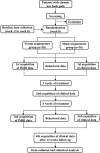The Emotion Regulation of Acupuncture in Chronic Low Back Pain: A Clinical Neuroimaging Protocol
- PMID: 38444878
- PMCID: PMC10913808
- DOI: 10.2147/JPR.S450589
The Emotion Regulation of Acupuncture in Chronic Low Back Pain: A Clinical Neuroimaging Protocol
Abstract
Introduction: Acupuncture is effective for patients with chronic low back pain (CLBP), which can relieve pain intensity and regulate negative emotional states such as pain-related anxiety and depression. Previous studies mainly discuss the analgesic mechanism of acupuncture treatment of CLBP, but there are multiple dimensions to pain, including sensation, emotion and cognition. Therefore, this study aims to investigate the central mechanism of acupuncture for CLBP from the perspective of emotional regulation by functional magnetic resonance imaging (fMRI).
Methods and analysis: A total of 72 patients with CLBP will be recruited in the study and randomly assigned to the verum acupuncture group or the sham acupuncture group. The trail will last for 18 weeks including a 2-week baseline, a 4-week treatment and a 12-week for follow-up period. The primary outcomes are the visual analog scale (VAS) and the Japanese Orthopaedic Association Scores (JOA) score. The secondary outcomes are the 12-item short form health survey (SF-12), the state trait anxiety inventory (STAI), the self-rating anxiety scale (SAS) and self-rating depression scale (SDS). The VAS, JOA, STAI SAS and SDS will be collected at baseline, week 2, week 4, and after follow-up. The SF-12 will be evaluated at baseline, week 2 and week 4. Functional magnetic resonance imaging (MRI) data will be collected at baseline and the end of treatment. Emotion-related brain regions will be chosen as regions of interest (ROIs). The gray matter volume (GMV), amplitude of low-frequency fluctuation (ALFF), regional homogeneity (ReHo), functional connectivity (FC), and large-scale functional brain network based on these ROIs will be analyzed within and between the two groups.
Discussion: This study will verify the emotional regulation of acupuncture and explore the mechanism of acupuncture for emotion regulation in patients with CLBP.
Trial registration number: https://www.chictr.org.cn/showproj.html?proj=195486, identifier: ChiCTR2300070557.
Keywords: acupuncture; chronic low back pain; emotion regulation; functional magnetic resonance imaging.
© 2024 Lai et al.
Conflict of interest statement
The authors declare that the research was conducted in the absence of any commercial or financial relationships that could be construed as a potential conflict of interest.
Figures


Similar articles
-
Regulatory Effects of Acupuncture on Emotional Disorders in Patients With Menstrual Migraine Without Aura: A Resting-State fMRI Study.Front Neurosci. 2021 Oct 4;15:726505. doi: 10.3389/fnins.2021.726505. eCollection 2021. Front Neurosci. 2021. PMID: 34671239 Free PMC article.
-
Neurological mechanism and efficacy of acupuncture for breast cancer-related insomnia: a study protocol for randomized clinical trial.Front Neurol. 2023 Dec 22;14:1278564. doi: 10.3389/fneur.2023.1278564. eCollection 2023. Front Neurol. 2023. PMID: 38187141 Free PMC article.
-
Shallow Acupuncture for Chronic Neck Pain: A Multicenter Randomized Controlled Trial Protocol with fMRI and DTI.J Pain Res. 2025 Apr 11;18:1963-1973. doi: 10.2147/JPR.S512989. eCollection 2025. J Pain Res. 2025. PMID: 40236722 Free PMC article.
-
Revealing the Neural Mechanism Underlying the Effects of Acupuncture on Migraine: A Systematic Review.Front Neurosci. 2021 May 20;15:674852. doi: 10.3389/fnins.2021.674852. eCollection 2021. Front Neurosci. 2021. PMID: 34093119 Free PMC article.
-
The Relationship Between Structural and Functional Brain Changes and Altered Emotion and Cognition in Chronic Low Back Pain Brain Changes: A Systematic Review of MRI and fMRI Studies.Clin J Pain. 2018 Mar;34(3):237-261. doi: 10.1097/AJP.0000000000000534. Clin J Pain. 2018. PMID: 28719509
Cited by
-
The effect of aspirin on lumbar degeneration: an imaging-based study.Front Surg. 2024 Dec 19;11:1515585. doi: 10.3389/fsurg.2024.1515585. eCollection 2024. Front Surg. 2024. PMID: 39749129 Free PMC article.
References
LinkOut - more resources
Full Text Sources

